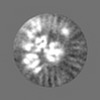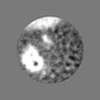+ Open data
Open data
- Basic information
Basic information
| Entry | Database: EMDB / ID: EMD-3906 | |||||||||
|---|---|---|---|---|---|---|---|---|---|---|
| Title | Cryo-EM density map of the human PLC editing module | |||||||||
 Map data Map data | CryoEM map of a protein complex | |||||||||
 Sample Sample |
| |||||||||
 Keywords Keywords | adaptive immunity / antigen processing / chaperone / MHC class I / IMMUNE SYSTEM | |||||||||
| Function / homology |  Function and homology information Function and homology informationMHC class Ib protein complex assembly / peptide antigen stabilization / Tapasin-ERp57 complex / response to biphenyl / Calnexin/calreticulin cycle / MHC class I protein complex binding / cytolytic granule / TAP2 binding / TAP1 binding / positive regulation of dendritic cell chemotaxis ...MHC class Ib protein complex assembly / peptide antigen stabilization / Tapasin-ERp57 complex / response to biphenyl / Calnexin/calreticulin cycle / MHC class I protein complex binding / cytolytic granule / TAP2 binding / TAP1 binding / positive regulation of dendritic cell chemotaxis / protein disulfide-isomerase / nuclear receptor-mediated glucocorticoid signaling pathway / Assembly of Viral Components at the Budding Site / ATF6 (ATF6-alpha) activates chaperone genes / negative regulation of trophoblast cell migration / cortical granule / cellular response to electrical stimulus / response to peptide / regulation of meiotic nuclear division / complement component C1q complex binding / sequestering of calcium ion / negative regulation of retinoic acid receptor signaling pathway / endoplasmic reticulum quality control compartment / protein folding in endoplasmic reticulum / sarcoplasmic reticulum lumen / disulfide oxidoreductase activity / negative regulation of intracellular steroid hormone receptor signaling pathway / regulation of protein complex stability / nuclear export signal receptor activity / phospholipase C activity / cardiac muscle cell differentiation / retrograde vesicle-mediated transport, Golgi to endoplasmic reticulum / cellular response to interleukin-7 / positive regulation of extrinsic apoptotic signaling pathway / cortical actin cytoskeleton organization / response to glycoside / positive regulation of memory T cell activation / T cell mediated cytotoxicity directed against tumor cell target / TAP complex binding / Scavenging by Class A Receptors / Golgi medial cisterna / positive regulation of CD8-positive, alpha-beta T cell activation / CD8-positive, alpha-beta T cell activation / positive regulation of CD8-positive, alpha-beta T cell proliferation / nuclear androgen receptor binding / Scavenging by Class F Receptors / cellular response to lithium ion / negative regulation of neuron differentiation / CD8 receptor binding / protein disulfide isomerase activity / lncRNA binding / response to testosterone / antigen processing and presentation of exogenous peptide antigen via MHC class I / beta-2-microglobulin binding / endoplasmic reticulum exit site / smooth endoplasmic reticulum / hormone binding / MHC class I protein binding / TAP binding / antigen processing and presentation of endogenous peptide antigen via MHC class I via ER pathway, TAP-dependent / protection from natural killer cell mediated cytotoxicity / protein-disulfide reductase activity / molecular sequestering activity / antigen processing and presentation of endogenous peptide antigen via MHC class I via ER pathway, TAP-independent / antigen processing and presentation of endogenous peptide antigen via MHC class Ib / protein localization to nucleus / detection of bacterium / T cell receptor binding / phagocytic vesicle / positive regulation of cell cycle / extrinsic apoptotic signaling pathway / ERAD pathway / endocytic vesicle lumen / endoplasmic reticulum-Golgi intermediate compartment membrane / protein folding chaperone / positive regulation of substrate adhesion-dependent cell spreading / positive regulation of endothelial cell migration / peptide binding / acrosomal vesicle / protein export from nucleus / positive regulation of phagocytosis / negative regulation of receptor binding / response to endoplasmic reticulum stress / early endosome lumen / Nef mediated downregulation of MHC class I complex cell surface expression / DAP12 interactions / protein maturation / transferrin transport / cellular response to iron ion / Endosomal/Vacuolar pathway / lumenal side of endoplasmic reticulum membrane / Antigen Presentation: Folding, assembly and peptide loading of class I MHC / peptide antigen assembly with MHC class II protein complex / cellular response to iron(III) ion / MHC class II protein complex / negative regulation of forebrain neuron differentiation / antigen processing and presentation of exogenous protein antigen via MHC class Ib, TAP-dependent / ER to Golgi transport vesicle membrane / peptide antigen assembly with MHC class I protein complex / regulation of iron ion transport Similarity search - Function | |||||||||
| Biological species |  Homo sapiens (human) Homo sapiens (human) | |||||||||
| Method | single particle reconstruction / cryo EM / Resolution: 5.8 Å | |||||||||
 Authors Authors | Januliene D / Blees A / Trowitzsch S / Tampe R / Moeller A | |||||||||
| Funding support |  Germany, 2 items Germany, 2 items
| |||||||||
 Citation Citation |  Journal: Nature / Year: 2017 Journal: Nature / Year: 2017Title: Structure of the human MHC-I peptide-loading complex. Authors: Andreas Blees / Dovile Januliene / Tommy Hofmann / Nicole Koller / Carla Schmidt / Simon Trowitzsch / Arne Moeller / Robert Tampé /  Abstract: The peptide-loading complex (PLC) is a transient, multisubunit membrane complex in the endoplasmic reticulum that is essential for establishing a hierarchical immune response. The PLC coordinates ...The peptide-loading complex (PLC) is a transient, multisubunit membrane complex in the endoplasmic reticulum that is essential for establishing a hierarchical immune response. The PLC coordinates peptide translocation into the endoplasmic reticulum with loading and editing of major histocompatibility complex class I (MHC-I) molecules. After final proofreading in the PLC, stable peptide-MHC-I complexes are released to the cell surface to evoke a T-cell response against infected or malignant cells. Sampling of different MHC-I allomorphs requires the precise coordination of seven different subunits in a single macromolecular assembly, including the transporter associated with antigen processing (TAP1 and TAP2, jointly referred to as TAP), the oxidoreductase ERp57, the MHC-I heterodimer, and the chaperones tapasin and calreticulin. The molecular organization of and mechanistic events that take place in the PLC are unknown owing to the heterogeneous composition and intrinsically dynamic nature of the complex. Here, we isolate human PLC from Burkitt's lymphoma cells using an engineered viral inhibitor as bait and determine the structure of native PLC by electron cryo-microscopy. Two endoplasmic reticulum-resident editing modules composed of tapasin, calreticulin, ERp57, and MHC-I are centred around TAP in a pseudo-symmetric orientation. A multivalent chaperone network within and across the editing modules establishes the proofreading function at two lateral binding platforms for MHC-I molecules. The lectin-like domain of calreticulin senses the MHC-I glycan, whereas the P domain reaches over the MHC-I peptide-binding pocket towards ERp57. This arrangement allows tapasin to facilitate peptide editing by clamping MHC-I. The translocation pathway of TAP opens out into a large endoplasmic reticulum lumenal cavity, confined by the membrane entry points of tapasin and MHC-I. Two lateral windows channel the antigenic peptides to MHC-I. Structures of PLC captured at distinct assembly states provide mechanistic insight into the recruitment and release of MHC-I. Our work defines the molecular symbiosis of an ABC transporter and an endoplasmic reticulum chaperone network in MHC-I assembly and provides insight into the onset of the adaptive immune response. | |||||||||
| History |
|
- Structure visualization
Structure visualization
| Movie |
 Movie viewer Movie viewer |
|---|---|
| Structure viewer | EM map:  SurfView SurfView Molmil Molmil Jmol/JSmol Jmol/JSmol |
| Supplemental images |
- Downloads & links
Downloads & links
-EMDB archive
| Map data |  emd_3906.map.gz emd_3906.map.gz | 25.5 MB |  EMDB map data format EMDB map data format | |
|---|---|---|---|---|
| Header (meta data) |  emd-3906-v30.xml emd-3906-v30.xml emd-3906.xml emd-3906.xml | 16 KB 16 KB | Display Display |  EMDB header EMDB header |
| Images |  emd_3906.png emd_3906.png | 44.5 KB | ||
| Filedesc metadata |  emd-3906.cif.gz emd-3906.cif.gz | 6.6 KB | ||
| Archive directory |  http://ftp.pdbj.org/pub/emdb/structures/EMD-3906 http://ftp.pdbj.org/pub/emdb/structures/EMD-3906 ftp://ftp.pdbj.org/pub/emdb/structures/EMD-3906 ftp://ftp.pdbj.org/pub/emdb/structures/EMD-3906 | HTTPS FTP |
-Validation report
| Summary document |  emd_3906_validation.pdf.gz emd_3906_validation.pdf.gz | 225.2 KB | Display |  EMDB validaton report EMDB validaton report |
|---|---|---|---|---|
| Full document |  emd_3906_full_validation.pdf.gz emd_3906_full_validation.pdf.gz | 224.3 KB | Display | |
| Data in XML |  emd_3906_validation.xml.gz emd_3906_validation.xml.gz | 5.7 KB | Display | |
| Arichive directory |  https://ftp.pdbj.org/pub/emdb/validation_reports/EMD-3906 https://ftp.pdbj.org/pub/emdb/validation_reports/EMD-3906 ftp://ftp.pdbj.org/pub/emdb/validation_reports/EMD-3906 ftp://ftp.pdbj.org/pub/emdb/validation_reports/EMD-3906 | HTTPS FTP |
-Related structure data
| Related structure data |  6enyMC  3904C  3905C C: citing same article ( M: atomic model generated by this map |
|---|---|
| Similar structure data |
- Links
Links
| EMDB pages |  EMDB (EBI/PDBe) / EMDB (EBI/PDBe) /  EMDataResource EMDataResource |
|---|---|
| Related items in Molecule of the Month |
- Map
Map
| File |  Download / File: emd_3906.map.gz / Format: CCP4 / Size: 30.5 MB / Type: IMAGE STORED AS FLOATING POINT NUMBER (4 BYTES) Download / File: emd_3906.map.gz / Format: CCP4 / Size: 30.5 MB / Type: IMAGE STORED AS FLOATING POINT NUMBER (4 BYTES) | ||||||||||||||||||||||||||||||||||||||||||||||||||||||||||||
|---|---|---|---|---|---|---|---|---|---|---|---|---|---|---|---|---|---|---|---|---|---|---|---|---|---|---|---|---|---|---|---|---|---|---|---|---|---|---|---|---|---|---|---|---|---|---|---|---|---|---|---|---|---|---|---|---|---|---|---|---|---|
| Annotation | CryoEM map of a protein complex | ||||||||||||||||||||||||||||||||||||||||||||||||||||||||||||
| Projections & slices | Image control
Images are generated by Spider. | ||||||||||||||||||||||||||||||||||||||||||||||||||||||||||||
| Voxel size | X=Y=Z: 1.077 Å | ||||||||||||||||||||||||||||||||||||||||||||||||||||||||||||
| Density |
| ||||||||||||||||||||||||||||||||||||||||||||||||||||||||||||
| Symmetry | Space group: 1 | ||||||||||||||||||||||||||||||||||||||||||||||||||||||||||||
| Details | EMDB XML:
CCP4 map header:
| ||||||||||||||||||||||||||||||||||||||||||||||||||||||||||||
-Supplemental data
- Sample components
Sample components
-Entire : Protein Complex
| Entire | Name: Protein Complex |
|---|---|
| Components |
|
-Supramolecule #1: Protein Complex
| Supramolecule | Name: Protein Complex / type: complex / ID: 1 / Parent: 0 / Macromolecule list: all |
|---|---|
| Source (natural) | Organism:  Homo sapiens (human) Homo sapiens (human) |
-Macromolecule #1: Beta-2-microglobulin
| Macromolecule | Name: Beta-2-microglobulin / type: protein_or_peptide / ID: 1 / Number of copies: 1 / Enantiomer: LEVO |
|---|---|
| Source (natural) | Organism:  Homo sapiens (human) Homo sapiens (human) |
| Molecular weight | Theoretical: 11.74816 KDa |
| Sequence | String: IQRTPKIQVY SRHPAENGKS NFLNCYVSGF HPSDIEVDLL KNGERIEKVE HSDLSFSKDW SFYLLYYTEF TPTEKDEYAC RVNHVTLSQ PKIVKWDRDM UniProtKB: Beta-2-microglobulin |
-Macromolecule #2: Tapasin
| Macromolecule | Name: Tapasin / type: protein_or_peptide / ID: 2 / Number of copies: 1 / Enantiomer: LEVO |
|---|---|
| Source (natural) | Organism:  Homo sapiens (human) Homo sapiens (human) |
| Molecular weight | Theoretical: 45.761184 KDa |
| Sequence | String: GPAVIECWFV EDASGKGLAK RPGALLLRQG PGEPPPRPDL DPELYLSVHD PAGALQAAFR RYPRGAPAPH CEMSRFVPLP ASAKWASGL TPAQNCPRAL DGAWLMVSIS SPVLSLSSLL RPQPEPQQEP VLITMATVVL TVLTHTPAPR VRLGQDALLD L SFAYMPPT ...String: GPAVIECWFV EDASGKGLAK RPGALLLRQG PGEPPPRPDL DPELYLSVHD PAGALQAAFR RYPRGAPAPH CEMSRFVPLP ASAKWASGL TPAQNCPRAL DGAWLMVSIS SPVLSLSSLL RPQPEPQQEP VLITMATVVL TVLTHTPAPR VRLGQDALLD L SFAYMPPT SEAASSLAPG PPPFGLEWRR QHLGKGHLLL AATPGLNGQM PAAQEGAVAF AAWDDDEPWG PWTGNGTFWL PR VQPFQEG TYLATIHLPY LQGQVTLELA VYKPPKVSLM PATLARAAPG EAPPELLCLV SHFYPSGGLE VEWELRGGPG GRS QKAEGQ RWLSALRHHS DGSVSLSGHL QPPPVTTEQH GARYACRIHH PSLPASGRSA EVTLEVAGLS GPSLEDSVGL FLSA FLLLG LFKALGWAAV YLSTCKDSKK KAE UniProtKB: Tapasin |
-Macromolecule #3: Protein disulfide-isomerase A3
| Macromolecule | Name: Protein disulfide-isomerase A3 / type: protein_or_peptide / ID: 3 / Number of copies: 1 / Enantiomer: LEVO / EC number: protein disulfide-isomerase |
|---|---|
| Source (natural) | Organism:  Homo sapiens (human) Homo sapiens (human) |
| Molecular weight | Theoretical: 54.341102 KDa |
| Sequence | String: SDVLELTDDN FESRISDTGS AGLMLVEFFA PWCGHCKRLA PEYEAAATRL KGIVPLAKVD CTANTNTCNK YGVSGYPTLK IFRDGEEAG AYDGPRTADG IVSHLKKQAG PASVPLRTEE EFKKFISDKD ASIVGFFDDS FSEAHSEFLK AASNLRDNYR F AHTNVESL ...String: SDVLELTDDN FESRISDTGS AGLMLVEFFA PWCGHCKRLA PEYEAAATRL KGIVPLAKVD CTANTNTCNK YGVSGYPTLK IFRDGEEAG AYDGPRTADG IVSHLKKQAG PASVPLRTEE EFKKFISDKD ASIVGFFDDS FSEAHSEFLK AASNLRDNYR F AHTNVESL VNEYDDNGEG IILFRPSHLT NKFEDKTVAY TEQKMTSGKI KKFIQENIFG ICPHMTEDNK DLIQGKDLLI AY YDVDYEK NAKGSNYWRN RVMMVAKKFL DAGHKLNFAV ASRKTFSHEL SDFGLESTAG EIPVVAIRTA KGEKFVMQEE FSR DGKALE RFLQDYFDGN LKRYLKSEPI PESNDGPVKV VVAENFDEIV NNENKDVLIE FYAPWCGHCK NLEPKYKELG EKLS KDPNI VIAKMDATAN DVPSPYEVRG FPTIYFSPAN KKLNPKKYEG GRELSDFISY LQREATNPPV IQEEKPKKKK KAQED L UniProtKB: Protein disulfide-isomerase A3 |
-Macromolecule #4: HLA class I histocompatibility antigen, A-3 alpha chain
| Macromolecule | Name: HLA class I histocompatibility antigen, A-3 alpha chain type: protein_or_peptide / ID: 4 / Number of copies: 1 / Enantiomer: LEVO |
|---|---|
| Source (natural) | Organism:  Homo sapiens (human) Homo sapiens (human) |
| Molecular weight | Theoretical: 38.363535 KDa |
| Sequence | String: GSHSMRYFFT SVSRPGRGEP RFIAVGYVDD TQFVRFDSDA ASQRMEPRAP WIEQEGPEYW DQETRNVKAQ SQTDRVDLGT LRGYYNQSE AGSHTIQIMY GCDVGSDGRF LRGYRQDAYD GKDYIALNED LRSWTAADMA AQITKRKWEA AHEAEQLRAY L DGTCVEWL ...String: GSHSMRYFFT SVSRPGRGEP RFIAVGYVDD TQFVRFDSDA ASQRMEPRAP WIEQEGPEYW DQETRNVKAQ SQTDRVDLGT LRGYYNQSE AGSHTIQIMY GCDVGSDGRF LRGYRQDAYD GKDYIALNED LRSWTAADMA AQITKRKWEA AHEAEQLRAY L DGTCVEWL RRYLENGKET LQRTDPPKTH MTHHPISDHE ATLRCWALGF YPAEITLTWQ RDGEDQTQDT ELVETRPAGD GT FQKWAAV VVPSGEEQRY TCHVQHEGLP KPLTLRWELS SQPTIPIVGI IAGLVLLGAV ITGAVVAAVM WRRKSSDRKG GSY TQAASS DSAQGSDVSL TACKV UniProtKB: HLA class I histocompatibility antigen, A alpha chain |
-Macromolecule #5: Calreticulin
| Macromolecule | Name: Calreticulin / type: protein_or_peptide / ID: 5 / Number of copies: 1 / Enantiomer: LEVO |
|---|---|
| Source (natural) | Organism:  Homo sapiens (human) Homo sapiens (human) |
| Molecular weight | Theoretical: 46.507145 KDa |
| Sequence | String: EPAVYFKEQF LDGDGWTSRW IESKHKSDFG KFVLSSGKFY GDEEKDKGLQ TSQDARFYAL SASFEPFSNK GQTLVVQFTV KHEQNIDCG GGYVKLFPNS LDQTDMHGDS EYNIMFGPDI CGPGTKKVHV IFNYKGKNVL INKDIRSKDD EFTHLYTLIV R PDNTYEVK ...String: EPAVYFKEQF LDGDGWTSRW IESKHKSDFG KFVLSSGKFY GDEEKDKGLQ TSQDARFYAL SASFEPFSNK GQTLVVQFTV KHEQNIDCG GGYVKLFPNS LDQTDMHGDS EYNIMFGPDI CGPGTKKVHV IFNYKGKNVL INKDIRSKDD EFTHLYTLIV R PDNTYEVK IDNSQVESGS LEDDWDFLPP KKIKDPDASK PEDWDERAKI DDPTDSKPED WDKPEHIPDP DAKKPEDWDE EM DGEWEPP VIQNPEYKGE WKPRQIDNPD YKGTWIHPEI DNPEYSPDPS IYAYDNFGVL GLDLWQVKSG TIFDNFLITN DEA YAEEFG NETWGVTKAA EKQMKDKQDE EQRLKEEEED KKRKEEEEAE DKEDDEDKDE DEEDEEDKEE DEEEDVPGQA KDEL UniProtKB: Calreticulin |
-Experimental details
-Structure determination
| Method | cryo EM |
|---|---|
 Processing Processing | single particle reconstruction |
| Aggregation state | particle |
- Sample preparation
Sample preparation
| Concentration | 2 mg/mL |
|---|---|
| Buffer | pH: 7.5 |
| Grid | Model: C-flat-2/2 / Pretreatment - Type: GLOW DISCHARGE |
| Vitrification | Cryogen name: ETHANE / Chamber humidity: 100 % / Chamber temperature: 277 K / Instrument: FEI VITROBOT MARK IV |
- Electron microscopy
Electron microscopy
| Microscope | FEI TITAN KRIOS |
|---|---|
| Image recording | Film or detector model: GATAN K2 QUANTUM (4k x 4k) / Detector mode: COUNTING / Average electron dose: 55.0 e/Å2 |
| Electron beam | Acceleration voltage: 300 kV / Electron source:  FIELD EMISSION GUN FIELD EMISSION GUN |
| Electron optics | Illumination mode: FLOOD BEAM / Imaging mode: BRIGHT FIELD |
| Experimental equipment |  Model: Titan Krios / Image courtesy: FEI Company |
- Image processing
Image processing
| Startup model | Type of model: OTHER Details: Selected particles from the best 2D class averages were subjected to 3D-classification in Relion, using a low-pass filtered global average as a starting model. The best map was then used as ...Details: Selected particles from the best 2D class averages were subjected to 3D-classification in Relion, using a low-pass filtered global average as a starting model. The best map was then used as an initial model for subsequent 3D classification. |
|---|---|
| Final reconstruction | Applied symmetry - Point group: C1 (asymmetric) / Resolution.type: BY AUTHOR / Resolution: 5.8 Å / Resolution method: FSC 0.143 CUT-OFF / Software - Name: FREALIGN (ver. X) / Number images used: 141078 |
| Initial angle assignment | Type: ANGULAR RECONSTITUTION / Software - Name: RELION (ver. 2.1) |
| Final angle assignment | Type: ANGULAR RECONSTITUTION |
 Movie
Movie Controller
Controller





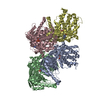

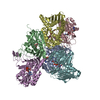


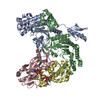
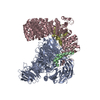





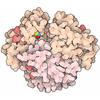

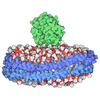

 Z (Sec.)
Z (Sec.) Y (Row.)
Y (Row.) X (Col.)
X (Col.)












